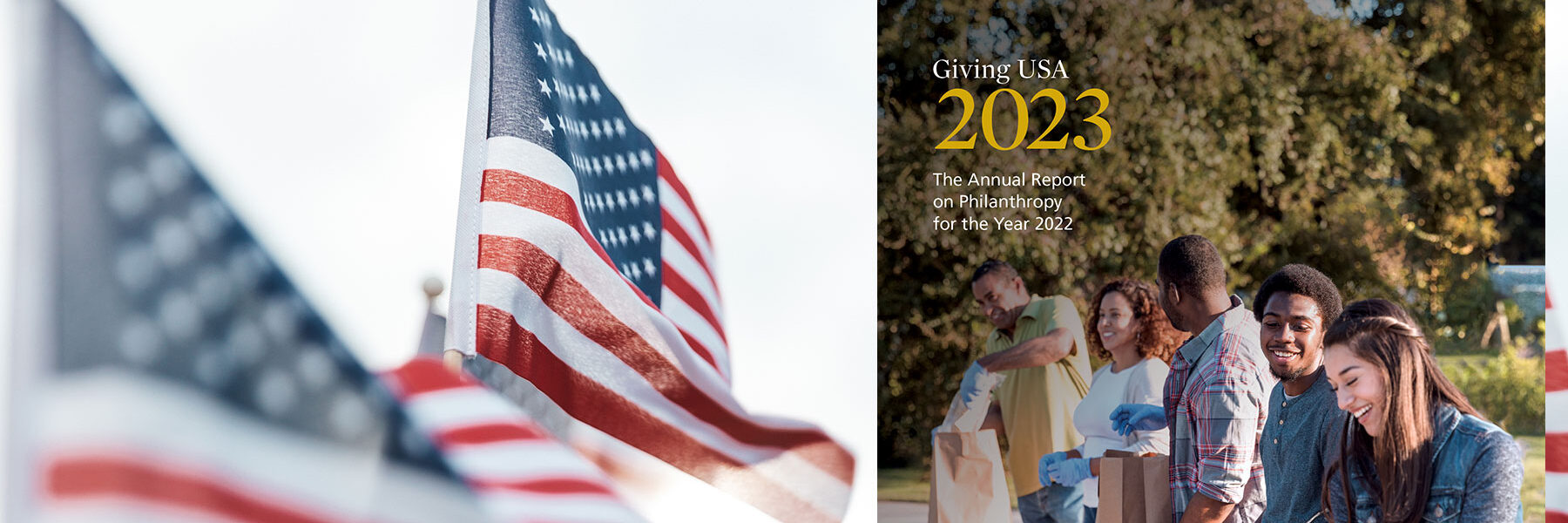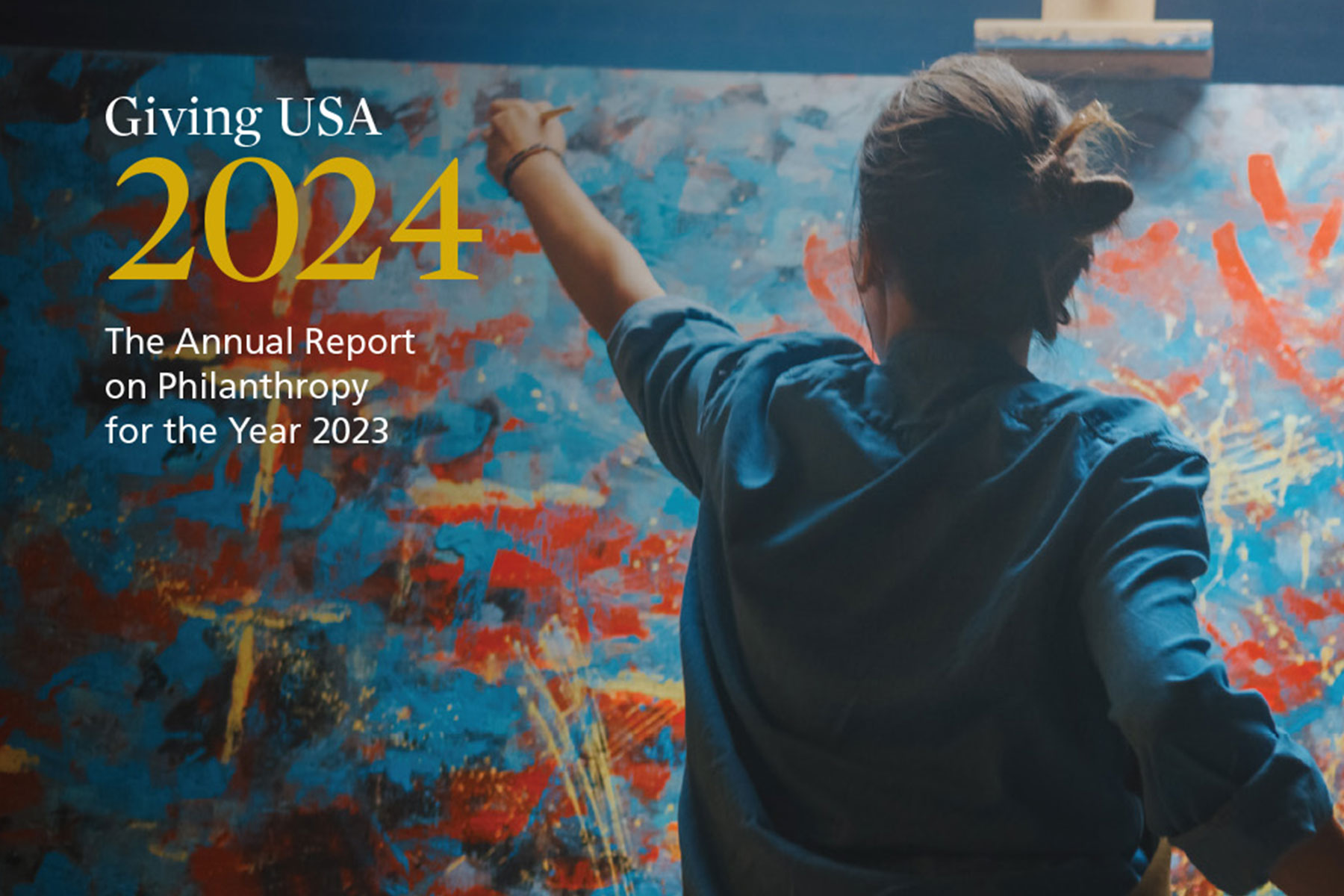As our country continues to grapple with the aftermath of a global pandemic as well as uncertain economic conditions, including the highest inflation rates in 40 years, the state of giving has indeed felt the impact.
The economic conditions in 2022 introduced new challenges to giving—from a decline in the stock market and disposable personal income to the continued and persistent high rates of inflation.
Despite these challenges, the resilience and innovation that arose during the COVID-19 pandemic will continue to benefit nonprofits moving forward. Over the past few years, online giving has grown substantially, demonstrating a necessity for nonprofits to expand their technology to not only survive, but thrive. Evolution will be a critical component to success and will include expanding online giving, building the future pipeline of donors and sustaining existing donors, and adapting and optimizing on all new giving tools such as AI.
During the height of the pandemic, we witnessed unprecedented generosity during a time of great need. Fast forward to today, while there was an overall decline in giving in 2022, it is important to note that this follows record-high giving numbers in 2020 and 2021. Additionally, with the Russian invasion of Ukraine, the American public has sought ways to send donations and support relief efforts, thereby increasing our international affairs giving data. Therefore, in comparison, though technically a decline, the total giving in 2022 of $499.33 billion stands as an incredible giving figure, representing the tenacious generosity and compassionate spirit of the American people.
BWF is excited to share the key findings from this year’s Giving USA: The Annual Report on Philanthropy. Presented by the research team at the Indiana University Lilly Family School of Philanthropy and the fundraising professionals at Giving USA Foundation, the Giving USA report is the longest-running, most extensive report on philanthropy in the United States. BWF is proud to be a member of The Giving Institute.
Key Findings from the Report:
In our review of the latest report, the following are the findings that stood out:
- The total estimated charitable giving in the United States reached $499.33 billion in 2022, which demonstrated a decline of 3.4 percent between 2021 and 2022. When adjusted for inflation, this showed a decline of 10.5 percent in overall growth.
- The four sources of giving showed mixed results vis-à-vis inflation rates.
- Giving by individuals totaled an estimated $319.04 billion, declining 6.4 percent in 2022 (a decline of 13.4 percent when adjusted for inflation) after two of the most generous giving years on record. Mega-gifts by individuals totaled $14 billion in 2022 and represented about 5 percent of all giving by individuals for the second year in a row.
- Giving by foundations grew 2.5 percent, to an estimated $105.21 billion in 2022 (a decline of 5 percent when adjusted for inflation). Giving by foundations is growing as a share of total giving.
- Giving by bequest totaled an estimated $45.60 billion in 2022, growing by 2.3 percent over 2021 (a decline of 5.3 percent when adjusted for inflation).
- Giving by corporations is estimated to have increased by 3.4 percent in 2022, totaling $29.48 billion (a decline of 4.2 percent when adjusted for inflation), demonstrating the strongest growth rate of all four sources.
- Giving to some of the major subsectors grew, but not enough to outpace inflation. These include religion (5.2 percent, -2.6 percent per inflation), health (5.1 percent, -2.6 percent per inflation), and arts, culture, and humanities (2.9 percent, -4.7 percent).
- Giving to international affairs is estimated to have stayed level with 2021 at a growth of 10.9 percent. However, adjusted per inflation, it still decreased 2.7 percent.
- The remaining subsectors declined overall from the highs reached during the pandemic era including giving to human services (-.6 percent, -8 percent per inflation), education (-3.6 percent, -10.7 percent per inflation), public-society (-8.4 percent, -15.2 percent per inflation), and environmental and animal organizations (-1.6 percent, -8.9 percent per inflation).
- The only subsector to outpace inflation was giving to foundations, which is estimated to have increased by 10.1 percent (1.9 percent per inflation), while giving to individuals stayed relatively flat with a 0.6 percent growth (-6.8 percent per inflation).
Implications and Impact
After back-to-back record-setting years in 2020 and 2021, overall charitable giving declined from $516.65 billion in 2021 to $499.33 billion in 2022. The experts point to a number of factors for this dip in giving, but economic uncertainty is the root cause. Looking back to the end of 2020, the economy was gaining momentum and returned to a position of strength in 2021. Gross Domestic Product rose to 5.9 percent in 2021, and the financial markets also showed significant strength, as clearly evidenced by double digit growth of the S&P 500, which is highly correlated with charitable giving. Inflation, at the time, was beginning to creep into the picture and causing consumers some heartburn, but in the end, 2021 held on to the top position for the best year in charitable giving history.
At the end of 2021, it was assumed that giving would continue to be strong in 2022 because the S&P 500 seemed to be humming along. In December of 2021, JP Morgan, Wells Fargo, and Goldman Sachs all predicted the S&P would exceed 5,000 at the end of 2022, keeping in mind that it was 4,686 on December 7, 2021. But sometimes even the experts get it wrong. The S&P fell by 19.4 percent in 2022. Inflation reached 8 percent, the highest it had been in 40 years. And personal disposable income was down by .1 percent, or -7.5 percent when adjusted for inflation.
Americans have enjoyed low inflation for more than three decades, and 2022 gave most people the opportunity to learn for the first time how to live in a high inflationary environment. As record prices at the gas pumps and steady increases in the cost of food and consumer goods caused a general “belt tightening” across the nation, nonprofit leaders began to fear a possible decline in charitable giving. One doesn’t need to be an economist to know that high inflation reduces one’s purchasing power and thus decreases one’s discretionary income. When donors have less income, they are inclined to give less, especially small-dollar donors. It is safe to say that the decline in the stock market combined with high inflation impacted donors’ financial reality and overall confidence in the economy, thereby impacting charitable giving.
Philanthropy from Individuals Still Leads the Way
Amid recession fears, market swings, and rising inflation and interest rates, individual philanthropists continued to demonstrate incredible generosity through their charitable giving in 2022. Individuals continue to comprise the largest source of total charitable giving in the United States, while making up 64 percent of all donations. While the percentage of individual giving is slightly down from its previous total of 67 percent, nearly half a trillion dollars were contributed by individuals in 2022, making up the lion’s share of the charitable giving pie. It is also important to keep in mind that if the percentages of individual and bequest giving are combined, the total is 73 percent of all donations, which doesn’t even factor in the gifts from family foundations that live within the foundation source. Individuals leading the charitable way is not a new trend; however, there were some interesting nuances in 2022 that should grab the attention of nonprofit leaders and inform fundraising strategy in the future.
Fundraisers have lived in an environment where overall donation amounts have continued to rise while the number of donors giving to charity declined. Contrary to this trend, the contribution amounts at all levels of the donor pyramid fell in 2022 as did the number of donors giving to charity. This not only means there are fewer donors overall, which impacts fundraising totals, it translates into fewer donors who could potentially mature into an organization’s next transformational donor. This reality impacts strategy and has nonprofits thinking about the shorter-term victories through high-impact comprehensive campaigns and longer-term efforts to build a base of support that will serve as the major gifts pipeline of the future.
Moving the Needle Quickly Through Transformative Giving
One trend that held constant in 2022 is giving by mega-gift donors, or donors who can make an incredible impact through their transformational philanthropy. As ordinary people around the world suffer from the lingering impacts of the pandemic and the current state of the global economy, billionaires have seen their fortunes expand. According to the Institute for Policy Studies analysis of Forbes data, the combined wealth of all the billionaires in the United States increased by $2.071 trillion or 70 percent between March 18, 2020, and October 15, 2021, from approximately $2.947 trillion to $5.019 trillion. Of the more than 700 billionaires, the richest five at the time—Jeff Bezos, Bill Gates, Mark Zuckerberg, Larry Page, and Elon Musk—saw a 123 percent increase in their combined wealth during this period, from $349 billion to $799 billion. It is an interesting (or maybe an alarming) fact to know that three men on the Forbes 400 richest list—Amazon founder Jeff Bezos, Microsoft founder Bill Gates, and investor Warren Buffett—held combined fortunes worth more than the total wealth of the poorest half of Americans.
Even if an organization doesn’t have billionaires in its portfolio of prospects, it is important to acknowledge that wealth inequality continues to increase domestically, and wealth is concentrated among a small percentage of individuals. These High-Net-Worth Individuals (HNWI) are responsible for a significant portion of total individual giving. The top 10 charitable gifts announced by individuals or their foundations in 2022 totaled nearly $9.3 billion, with a $5 billion gift from Bill Gates topping the list, according to The Chronicle of Philanthropy. The total of mega-gifts in 2022 hit the $14 billion mark and represented about 5 percent of all giving by individuals for the second year in a row. Gifts from donors like Bill Gates, MacKenzie Scott and Dan Jewett, Steve Ballmer, Warren Buffett, and others are transformational for universities and nonprofit organizations. More importantly, they help illustrate the importance of the work that takes place at the top of the donor pyramid.
With equity markets primed to rebound, last year’s strong lean towards giving non-cash assets is likely to continue. As organizations make near-term investments in their fundraising operations, they should consider the immediate impact that their organization could make at the top of the donor pyramid. Baby Boomers have amassed immense wealth and have appreciated assets at their disposal to give. While there is significant opportunity for current gifts from this generation, it is also a fact that there is an opportunity to assist them with their legacy plans. Many of them have not taken the time to create an estate plan and will need assistance in helping them establish a vision and plan for passing along their charitable values.
A best practice of highly effective fundraising shops is to commit dedicated resources to support a principal gifts program. Regardless of what size of gifts qualify at this level of support for an organization, there needs to be a centralized department that works with organizational leadership to develop and coordinate the donor strategies and the players involved to keep activity at the top of the donor pyramid running like a well-oiled machine. Collaboration, coordination, and communication among the frontline gift officers, the prospect development team, advancement and organizational leadership, and volunteers are essential components to ensuring high quality experiences for these donor investors so they understand the return on their investments.
Donors Have Become Much More Sophisticated, So Should We
Giving has become much more diversified in today’s philanthropic marketplace. Donors at all levels, not just HNWI, are seeking savvy, strategic, and convenient ways to support their charities of choice, maximize their tax and financial situations, and make greater impacts to improve the world that we live in. As donor sophistication increases, so must our ability to understand the tools, language, and vehicles that they are using. For example, even though Donor Advised Funds (DAFs) were established nearly a century ago at community foundations around the country, they have risen in tremendous popularity over the past decade and have recently surpassed $250 billion in total assets. Using unusual assets like cryptocurrency, commodities, an equity stake in a company, IPO stock, and other non-cash assets to make gifts is becoming commonplace amongst donors. The level of philanthropic education and access to information for donors are opening new doors to transformative opportunities for our organizations, and we must be ready to understand how to accept these forms of philanthropy.
Competition Will Only Make Us Better
In 2022, individual giving as a percentage of disposable personal income reached its lowest level of 1.7 percent since 1995. With a flooded philanthropic marketplace, fewer numbers of donors giving to charity, and shrinking donation sizes at all donor segments, competition for the donor dollar is fierce, creating space for innovative and entrepreneurial marketing strategies. As organizations attempt to differentiate themselves from their competitors, it is more imperative than ever before to be able to articulate a crystal-clear funding position through a compelling case for support that will appeal to a broader audience.
Many of us who have been in the fundraising industry for several decades have seen a definite shift in donor behavior based on generation. Our more “mature in age” donors typically gave out of loyalty and may have taken a more hands-off approach to their philanthropy. Gen Z and Millennials want to take a more active approach to giving and tend to gravitate toward supporting causes through active volunteerism and giving annually. Whether you work for a major university or a small nonprofit organization, cause-related donor acquisition and a case for support that elicits cause-related philanthropic investment have become a necessity in all messaging and marketing efforts.
Corporate and Foundation Giving Holding Strong
While giving by foundations, bequests, and corporations all grew in current dollars in 2022, only corporations and foundations experienced two-year growth, even after adjusting for inflation. In 2021, many of the corporate sub-sectors that were affected by the pandemic experienced some level of recovery that helped to contribute to a rise in overall pre-tax profits, by 37.4 percent, thereby creating more philanthropic dollars to be given away. In 2022, there were two contributing factors that contributed to a better than average performance—GDP and pre-tax profits. GDP increased 9.2 percent, or 1.1 percent adjusted for inflation, and pre-tax profits increased by 6.6 percent, or -1.3 percent adjusted for inflation. It is an obvious but important point to note that corporations give in various ways to nonprofit organizations over and above what is typically considered philanthropic dollars. Corporate giving is complex and extends beyond altruism to goodwill, marketing, and overcoming negative publicity. In many ways, it is best to think of the relationships that nonprofits have with corporations as strategic partnerships.
Corporations continue to direct the majority of their philanthropic investments to issues and causes of diversity, equity, inclusion, and social justice as well as workforce development opportunities. While DEIJ initiatives and programs within nonprofits have become priorities for organizations, they need to be marketed and have a strong presence among giving offerings. Corporations are also aggressively trying to diversify their workforce with employees that have knowledge about theory and experience with application within their industries. Encouraging workplace volunteer programs and opportunities for employee involvement will build a stronger culture among the corporate employee base, while shining a light on opportunities for philanthropic investment.
One of the biggest headlines and surprises of 2022 was the growth experienced in foundation giving. When looking at the history of giving by foundations over the past 20 years, it’s rather remarkable. In 1982, foundations were responsible for 5 percent of total giving. In 2022, that number has grown to 21 percent, or $1 of every $5 given to charity. Digging a little deeper into the data, roughly 50 percent of foundation giving consists of family foundation giving, which emphasizes the importance of both institutional and individual relationship building in the overall foundation giving space.
While charitable giving from individuals is the hallmark of a successful fundraising program, corporate and foundation giving are important to a well-balanced fundraising operation. The fact that corporations and foundations have experienced growth even when adjusting for inflation tells us that institutional support has not wavered during economic uncertainty.
Technology Can Be Our Friend
Online engagement is a critical component of a nonprofit organization’s communication, fundraising, advocacy, and stewardship strategies. During the pandemic, we witnessed record growth in online giving across all sectors, and the American people are becoming more comfortable using digital means to make their gifts, especially at the middle and base of the pyramid. In 2022, mobile devices were responsible for the majority of all visits to nonprofit websites, and over 75 percent of the surveyed Gen Z and Millennial donors reported preferring giving online. This trend, coupled with the understanding that the younger generation gives to values-based causes like education, social justice issues, animal welfare, and mental health, should influence how the donor experience or donor journey is created for these audiences.
Giving to the international affairs subsector is one of the best illustrations of how the American people rallied around the international crisis of Russia’s invasion of Ukraine through their online support. International Affairs increased by nearly 11 percent and was one of the few subsectors that outpaced inflation.
BWF has assisted hundreds of forward-thinking organizations in developing digital engagement centers that has led to lead generation, warming of the base, and donor journeys that will build the donor pipeline of the future and retain donors through thoughtful stewardship. An overall engagement strategy that creates a tailored journey by incorporating email, text messaging, and personalized videos with tools such as ethical artificial intelligence will result in an overall better donor experience and convert one-time gifts into repeat donors.
A Deeper Dive Into the Subsectors
The data associated with the philanthropic sub-sectors tells an interesting story in 2022. Education and human service organizations performed extremely well during the pandemic but experienced declines in current dollars during the past year. Although the declines may cause some concern within these two subsectors, giving to public and private universities continues to be exceptionally strong, and both the number of currently active campaigns and their associated campaign goals have continued to rise and generate billions of dollars to educational causes. It is important to note that giving to human service organizations edged education in total giving for the first time in history. It has now moved into the second leading recipient of charitable giving, with 14 percent of the pie. Among all subsectors, international affairs was the big winner, experiencing nearly 11 percent growth in current dollars over a year ago. Events like the war in Ukraine and other humanitarian crises around the globe can explain the tremendous growth in this sub-sector. In fact, only international affairs and foundations outpaced inflation in 2022. Religion, health, and arts, culture, and humanities also sustained small to moderate growth in current dollars but declined because of inflation.
It is difficult to derive definitive trends within the subsectors in 2022 because many of them experienced record growth in giving during the pandemic. As the pandemic curtailed from the end of 2020 and into 2021 and occupied less of the media spotlight, donors started to demonstrate pre-pandemic behavior by supporting causes that they had previously supported. Given the current economic conditions, heightened awareness of wars and unrest around the world, and an upcoming political election, it is difficult to predict the future of charitable giving behavior in the coming year. As a result of these murky waters, nonprofit organizations must strive to remain relevant and sustain their shares within the philanthropic marketplace by creating meaningful experiences for their donors, demonstrating and articulating the return on philanthropic investment, and accentuating the unique causes that each represents.
Looking Ahead
What we have learned in 2022 is that trends in the philanthropic marketplace contribute to a very complex and ever-evolving understanding of how to approach the future. While the economic conditions of 2022 caused an overall decline in giving, philanthropy continues to be very strong in the United States and plays a significant role in solving the issues and problems in today’s society. Donors continue to show adaptability and resiliency in their giving behaviors, which is a testament to the work we do and the differences we have made for the greater good. We should all celebrate the incredible generosity demonstrated in 2022 and focus on keeping donors informed, close, and well stewarded as they partner with us in 2023 and beyond.




